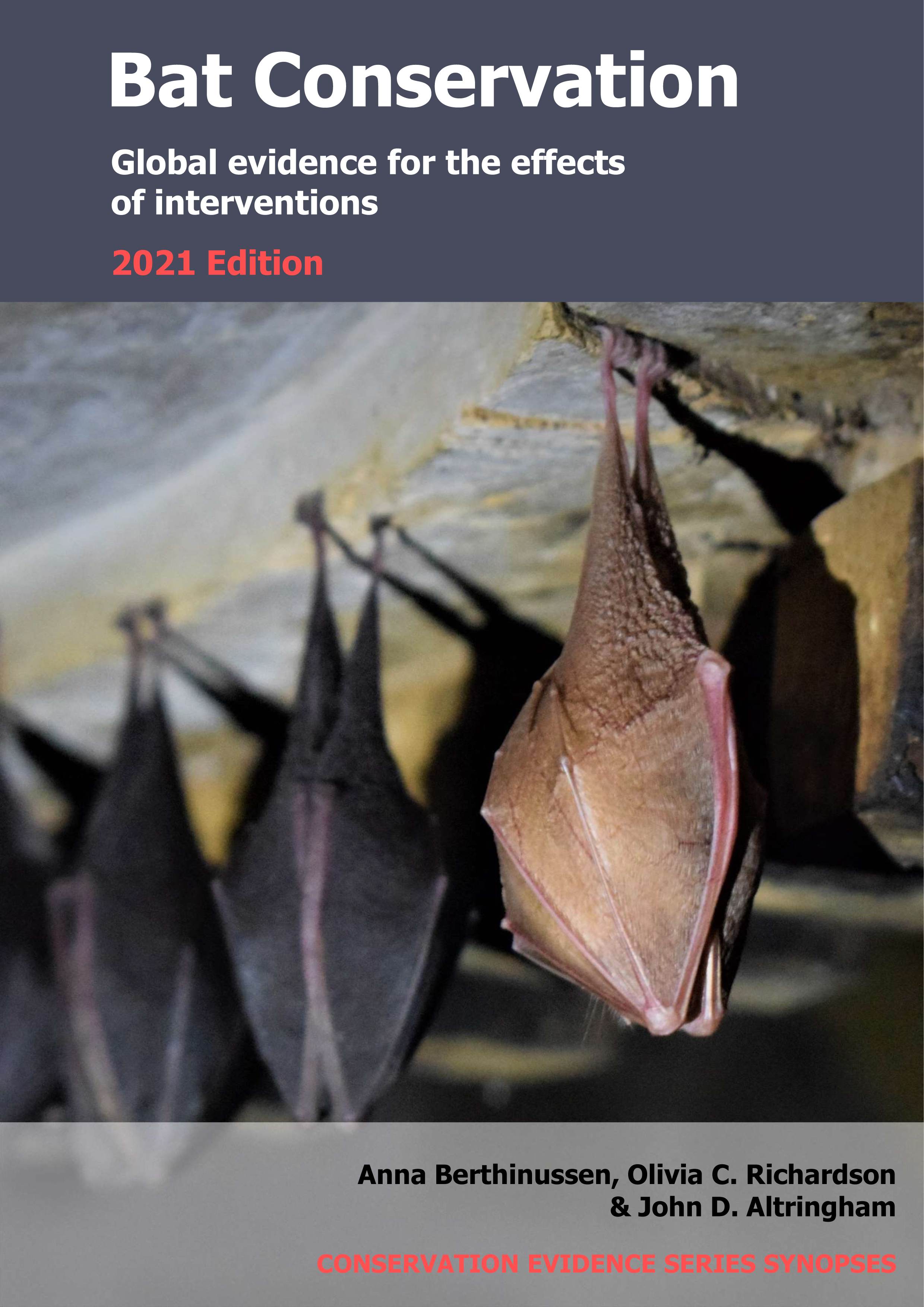Reduce pesticide, herbicide or fertiliser use
-
Overall effectiveness category Likely to be beneficial
-
Number of studies: 4
View assessment score
Hide assessment score
How is the evidence assessed?
-
Effectiveness
77% -
Certainty
60% -
Harms
0%
Study locations
Supporting evidence from individual studies
A site comparison study in 2004–2005 in five agroforestry plantations and one montane rainforest in southeastern Chiapas, Mexico (Estrada et al 2006) found that coffee agroforestry plantations using few or no chemicals had a higher diversity of insect-eating bat species than coffee agroforestry plantations with high chemical inputs, but the diversity of fruit and nectar-eating bat species did not differ. A higher diversity of insect-eating bat species was captured in plantations with low chemical use than in plantations with high chemical inputs (data reported as diversity index). The number of fruit and nectar-eating bat species was similar in plantations with low and high chemical use. More bat species were recorded in native rainforest (37 species) than in any of the five coffee agroforestry plantations (23–26 species). One site of native rainforest was sampled, and five sites on coffee agroforestry plantations with different amounts of chemical use (either none, organic compost, or different combinations of Thiodan, herbicide and fertilizer). Plantations with the highest chemical input used all three chemical types. At each of six sites, bats were captured with six mist nets placed along a 150 m transect for 6 h from sunset on two nights. Surveys were repeated every 50 days from March 2004 to June 2005.
Study and other actions testedA replicated, site comparison study in 2010 of 36 Mediterranean olive farms in southwestern Portugal (Herrera et al 2015) found that traditional farms using few or no chemicals had greater bat activity and different compositions of bat species than intensive farms using high chemical inputs, but they did not differ significantly from semi-intensive farms. Bat activity overall was higher in traditional farms (average 6 bat passes/night) than intensive farms (1 bat pass/night). Species composition also differed (data reported as Sørenson’s index). No significant differences in bat activity or species composition were found between traditional and semi-intensive farms (average 3 bat passes/night). At least eight bat species were recorded (see original paper for data for individual species). Thirty-six olive farms (13 traditional, 12 semi-intensive and 11 intensive) were surveyed. Traditional farms used few or no chemicals, semi-intensive farms used a moderate chemical input and intensive farms used high and frequent chemical inputs (dimethoate and deltamethrin). Tree density and the use of mechanical methods varied between farms. Three olive farms (one per management type) were simultaneously surveyed every night for one week between July and September 2010 with a bat detector deployed in the centre of each farm.
Study and other actions testedA site comparison study in 2012–2013 of three grassland sites in Brandenburg, Germany (Starik et al 2018) found that grasslands with moderate or no fertiliser applications had higher overall bat activity and more bat species than a grassland with high amounts of fertiliser applied. Overall bat activity (of 11 bat species) and the number of bat species recorded were higher over grasslands with moderate (average 11 bat passes/hour, 7 bat species/night) or no fertiliser applications (17 bat passes/hour, 7 bat species/night) than high fertiliser applications (5 bat passes/hour, 5 bat species/night). One site (1 ha) was sampled in each of three grasslands treated with different amounts of nitrogen (N) fertiliser (high applications: 225 kg/ha; moderate: 100 kg/ha; none applied). The site with high fertiliser applications was harvested three times/year, and the site with moderate fertiliser application was grazed (1 cow/ha). Sites were located a similar distance to settlements, water bodies and other land use types. At each of three sites, two bat detectors recorded bat activity simultaneously over a total of 46 nights in May–October 2012 and April–October 2013.
Study and other actions testedA replicated, site comparison study in 2011–2012 of four tropical forest fragments in livestock farming areas in Córdoba, Columbia (Chacón-Pacheco & Ballesteros-Correa 2019) found that great fruit-eating bats Artibeus lituratus captured in ‘silvopastoral’ areas that used no chemicals, along with agroforestry, had higher body weights and body condition scores than those within conventional farming areas that used chemicals. Great fruit-eating bats captured in ‘silvopastoral’ areas had a higher average body weight (64 g) and body condition score (0.93) than those captured in conventional farming areas (59.5 g; 0.86). In August 2011–July 2012, great fruit-eating bats were captured at forest fragments within each of two ‘silvopastoral’ areas (total 260 bats) and two conventional farming areas (total 69 bats). ‘Silvopastoral’ areas grazed livestock amongst trees, shrubs, and crops, without chemicals. Conventional areas grazed livestock in monocultures with little tree or shrub cover, and used agrochemicals, pesticides, and herbicides. Each of four sites was sampled 15 times for three consecutive nights with mist nets (6 x 3 m) deployed within the forest fragment (nine nets) and surrounding area (five nets). Nets were deployed for 12 h/night (18:00–06:00 h) and checked every 45 minutes. Each captured bat was weighed, forearm length was measured, and body condition calculated (body weight/forearm length). Bats were marked before release.
Study and other actions tested
Where has this evidence come from?
List of journals searched by synopsis
All the journals searched for all synopses
This Action forms part of the Action Synopsis:
Bat Conservation
Bat Conservation - Published 2021
Update 2020





)_2023.JPG)














